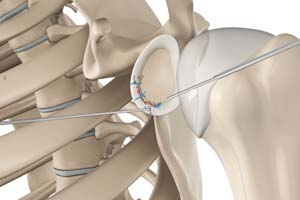
Shoulder Anatomy
The shoulder joint (glenohumeral joint) is a ball and socket joint, where the head of the upper arm bone (humerus) attaches to the shoulder socket (glenoid cavity). The shoulder socket is extremely shallow and therefore needs additional support to keep the shoulder bones from dislocating. The labrum, a cuff of cartilage that encircles the shoulder socket, helps serve this purpose by forming a cup for the humeral head to move within. It provides stability to the joint, enabling a wide range of movements.
What is a Bankart Tear?
The labrum can sometimes tear during a shoulder injury. A specific type of labral tear that occurs when the shoulder dislocates out the front is called a Bankart tear. This is a tear to a part of the labrum called the inferior glenohumeral ligament and is common in the young who sustain a dislocation of the shoulder. A Bankart tear makes the shoulder prone to repeat dislocation in patients under 30 years of age.
How is a Bankart Tear Diagnosed?
Your physician will ask about your medical history and perform a thorough physical examination of your shoulder. Your doctor may recommend an additional X-ray or MRI.
What are the Treatment Options?
Conservative treatment measures for a Bankart tear include rest and immobilization with a sling, followed by physical therapy.
Bankart repair surgery is indicated for a Bankart tear when conservative treatment measures do not improve the condition but instead results in repeated shoulder joint instability.
Arthroscopic Bankart Repair Procedure
Bankart surgery can be performed by a minimally invasive surgical technique called arthroscopy.
- During an arthroscopic Bankart procedure, your surgeon makes a few small incisions over your shoulder joint.
- An arthroscope, a slender tubular device attached with a light and a small video camera at the end is inserted through one of the incisions into your shoulder joint.
- The video camera transmits the image of the inside of your shoulder joint onto a television monitor for your surgeon to view.
- Suture anchors are then inserted to reattach the detached labrum to the glenoid. The tiny incisions are then closed and covered with a bandage.
- Arthroscopy causes minimal disruption to the other shoulder structures and does not require your surgeon to detach and reattach the overlying shoulder muscle (subscapularis) as with the open technique.
Postoperative Care for Arthroscopic Bankart Repair
The following are the postoperative care details following arthroscopic Bankart repair:
- After your surgery, you will spend about an hour in the recovery room.
- You will be allowed to perform your daily activities as tolerated, but without lifting objects heavier than a plate or glass, while you heal.
- Your arm may be placed in a sling for 3-4 weeks to restrict the use of your operated shoulder.
- You may resume light low-risk activities like jogging and swimming 8 to 10 weeks after surgery and may be advised to avoid contact sports for some time.
Risks and Complications of Arthroscopic Bankart Repair
Arthroscopic Bankart repair is a relatively safe procedure. Being minimally invasive, it is associated with fewer risks and a quicker recovery. Some of the potential risks include:
- Infection
- Injury to adjacent nerves or blood vessels
- The stiffness of the joint
- Pain
Related Topics
- Proximal Biceps Tenodesis
- Intraarticular Shoulder Injection
- Arthroscopic Acromioplasty
- Shoulder Joint Replacement
- Reverse Shoulder Replacement
- Rotator Cuff Repair
- SLAP Repair
- Arthroscopic Bankart Repair
- Arthroscopic Frozen Shoulder Release
- Latarjet Procedure
- Shoulder Arthroscopy
- Distal Clavicle Excision
- Pectoralis Major Tears/Repairs
- ORIF of the Clavicle Fractures
- Arthroscopic Superior Capsular Reconstruction (SCR)
- Subacromial Decompression
- Shoulder Resurfacing
- Acromioclavicular (AC) Joint Reconstruction





